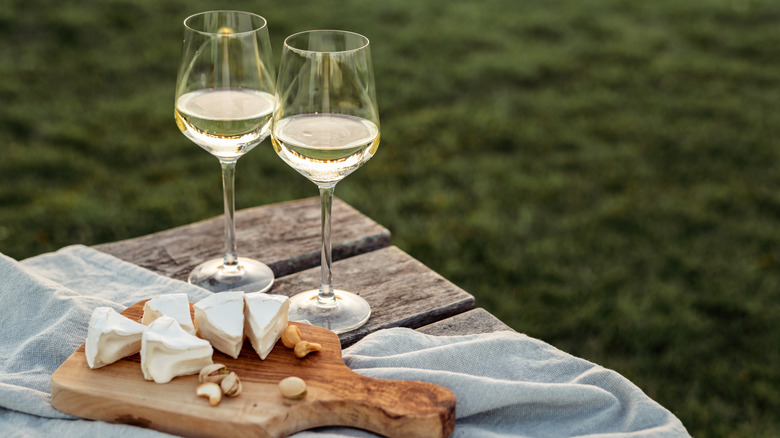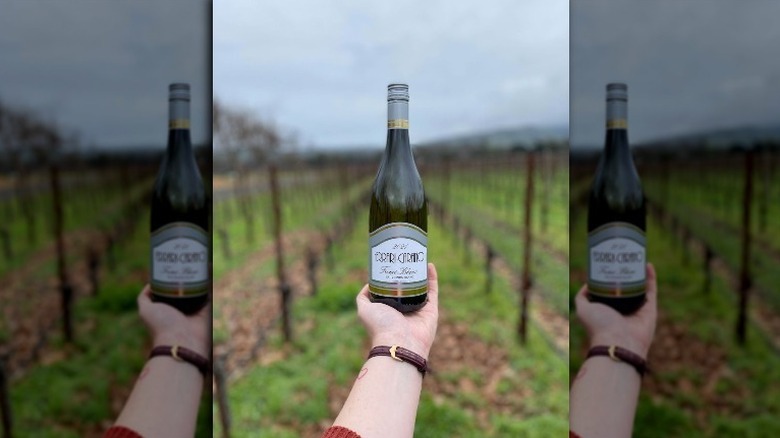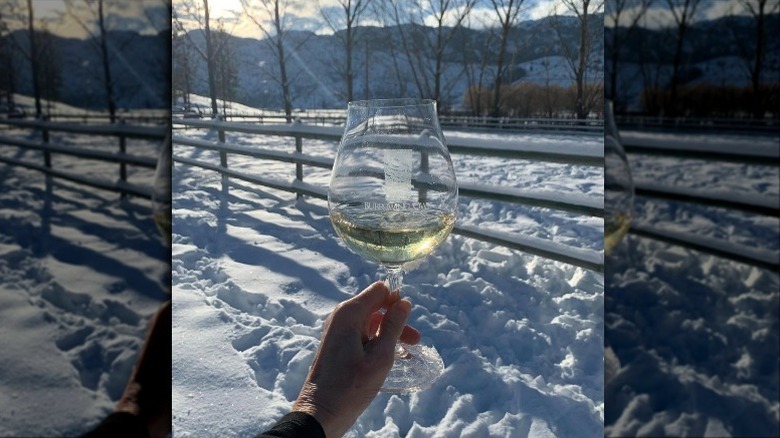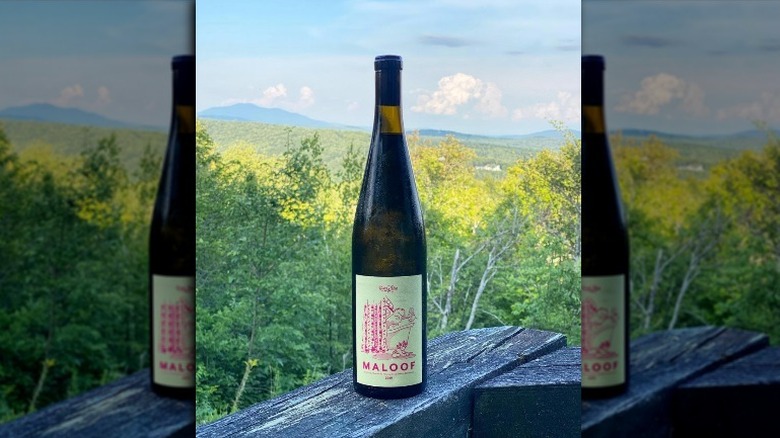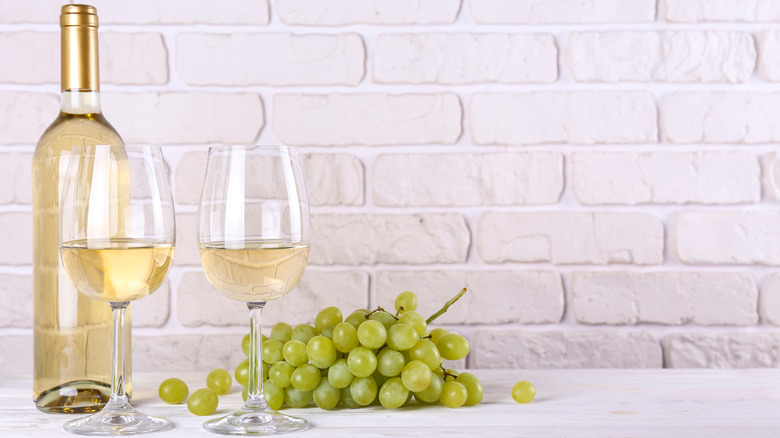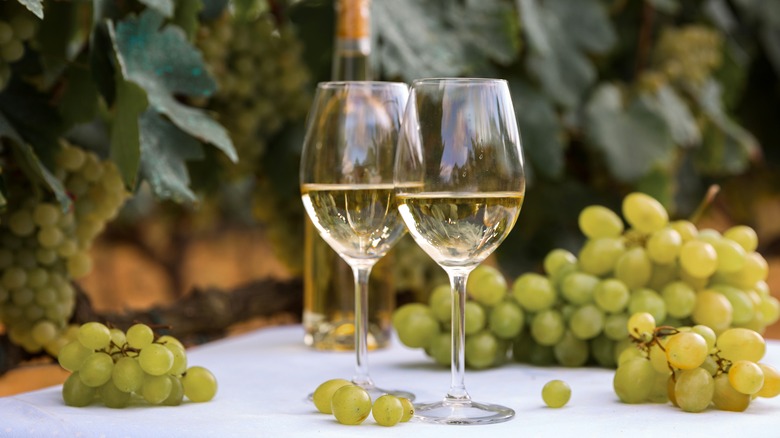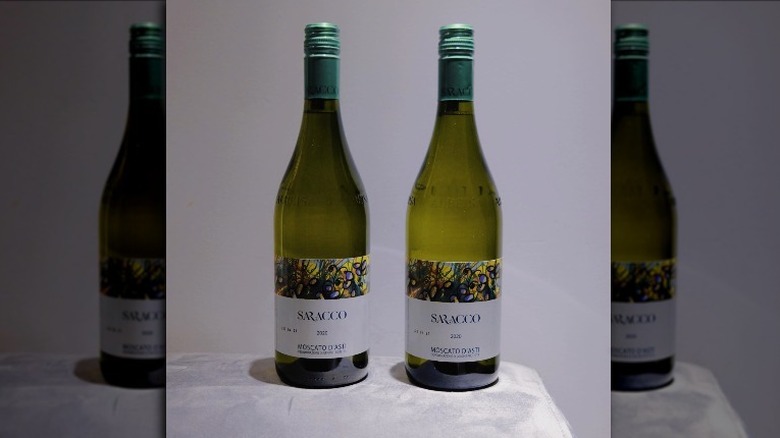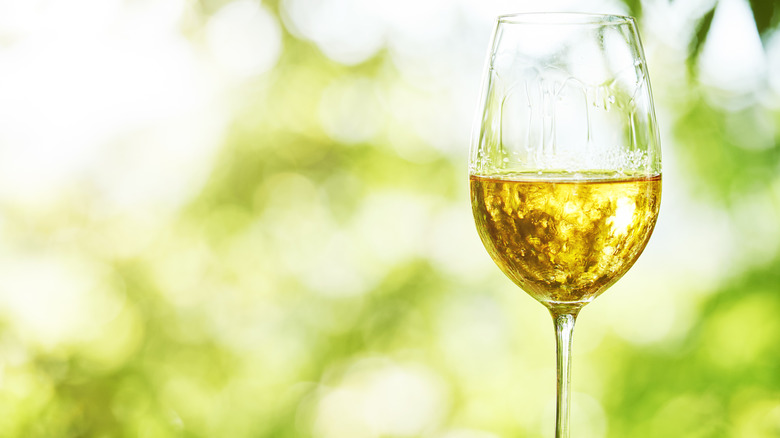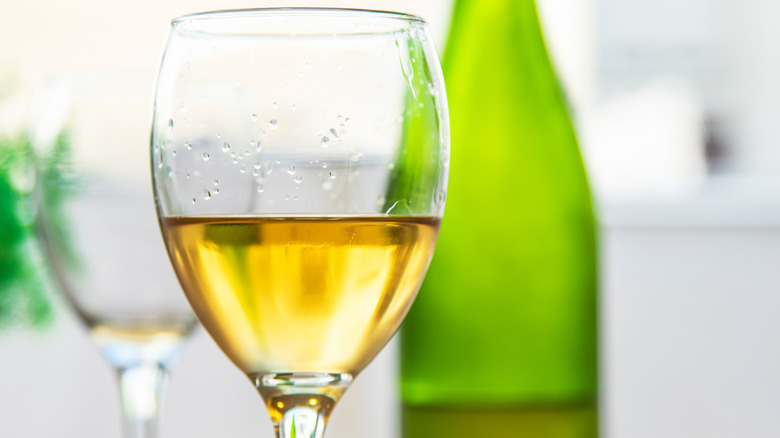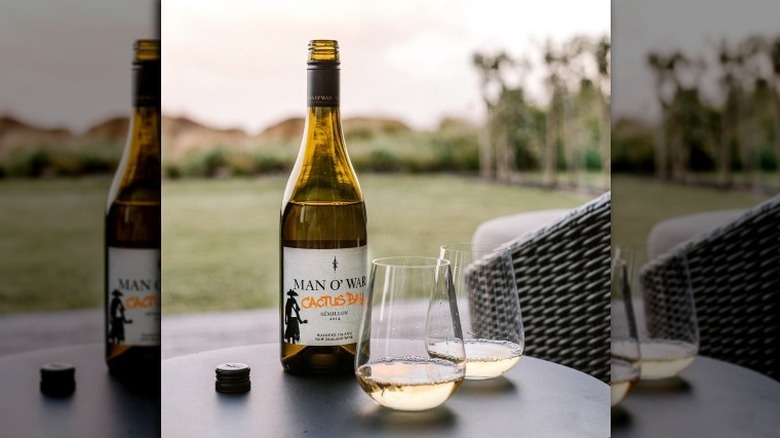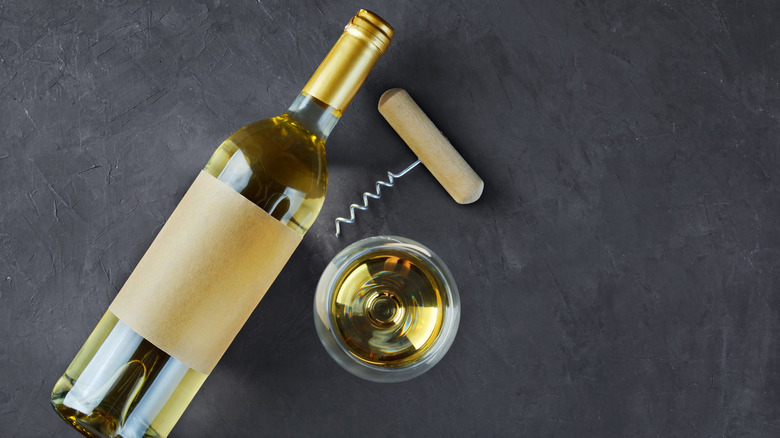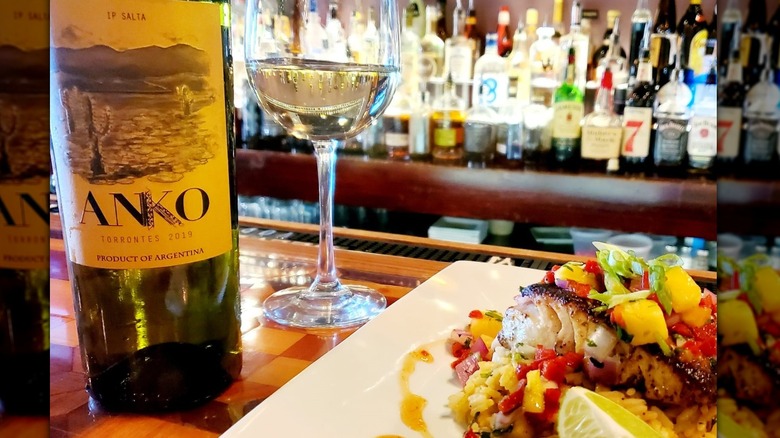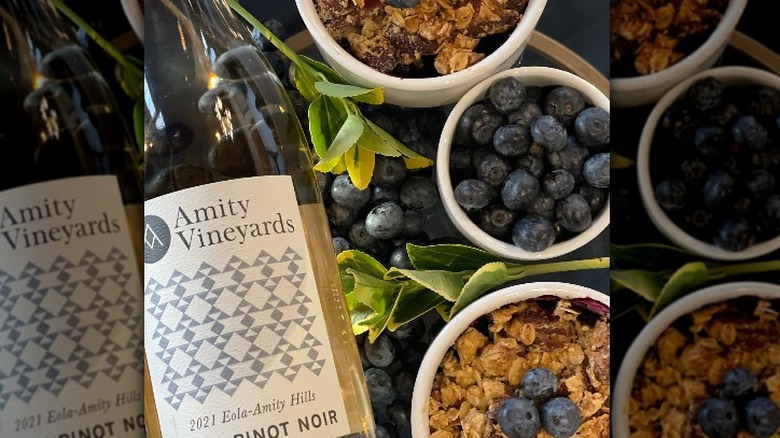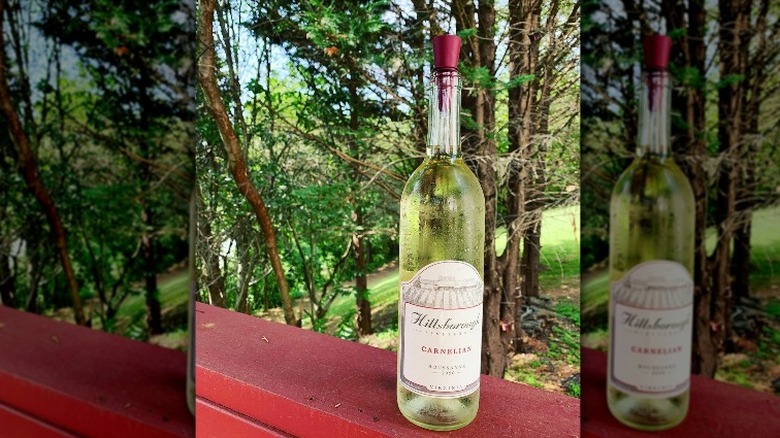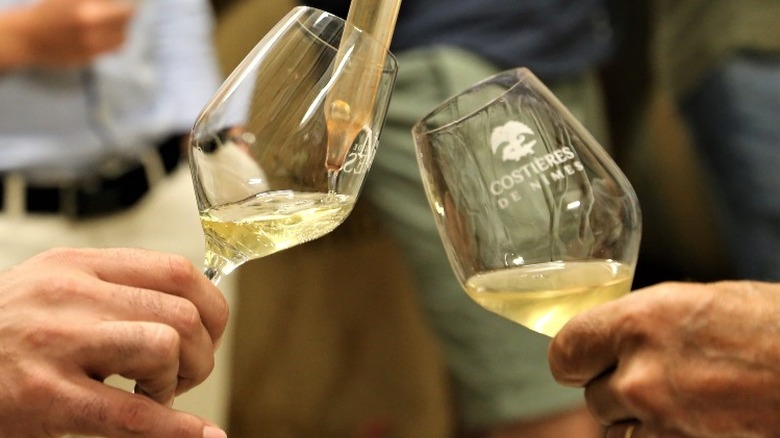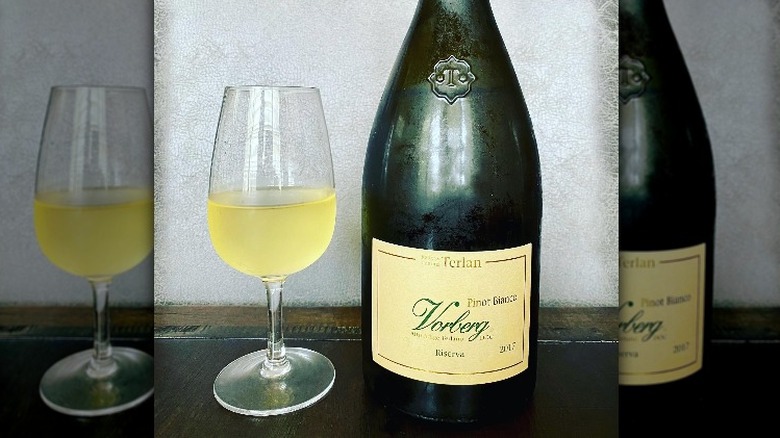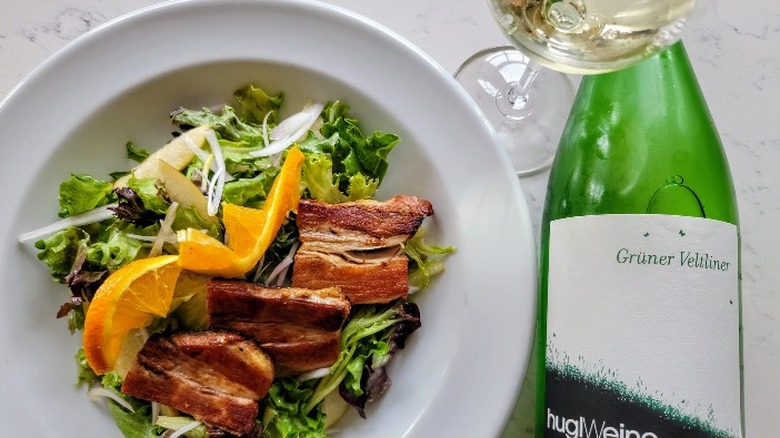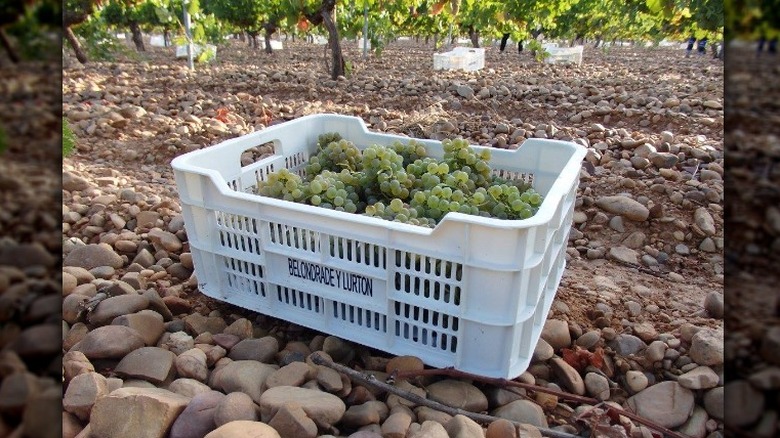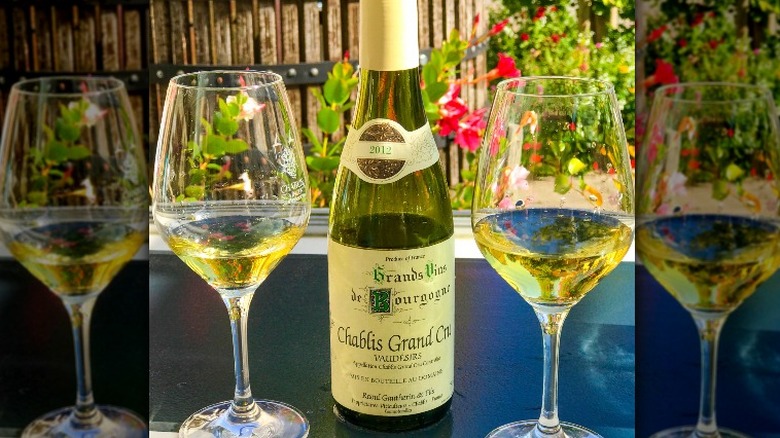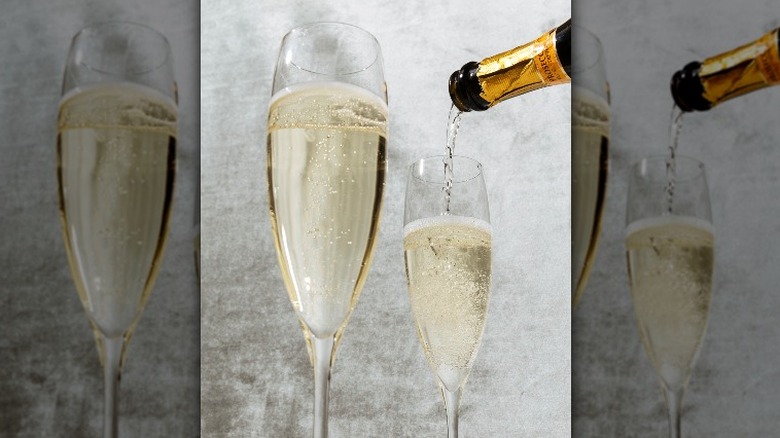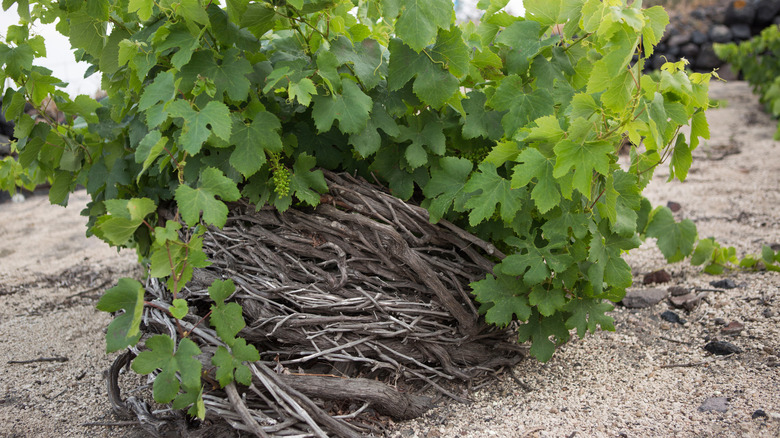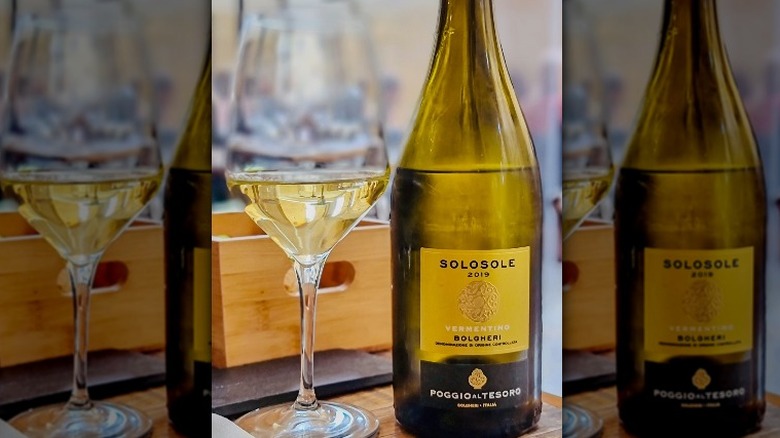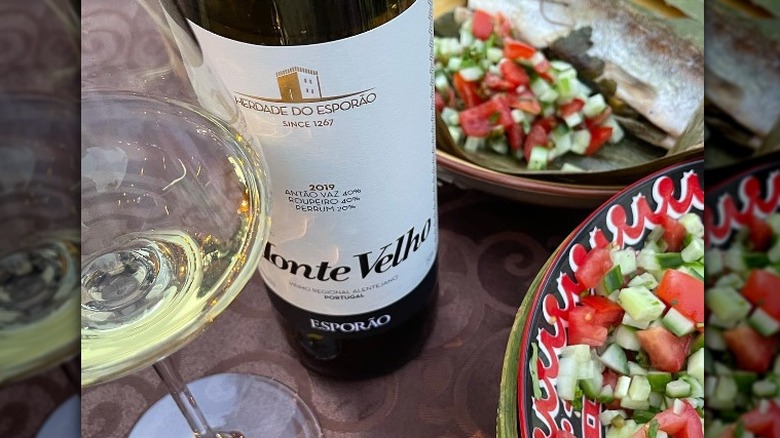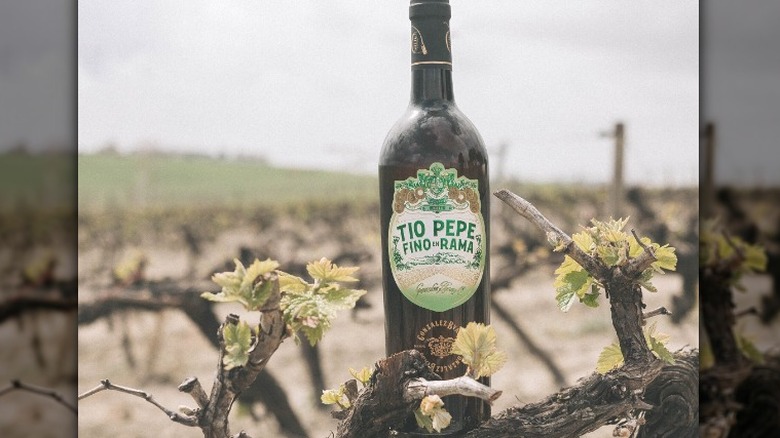Every Major Type Of White Wine You Would Ever Need To Know
Some seem to think that red wine is always the go-to option for real wine lovers, but that's far from the truth. While reds are often recognized for their fullness and tannin, white wines can be equally interesting with their minerality, acidity, and crispness. We love bringing white wine to the beach or a summertime picnic, and they're usually just what you're looking for when you want to pair wine and seafood. If you haven't found a white wine you like yet, it may be because you haven't been trying the right varieties. There are so many different white wines to choose from, but we're going to cover 10 of the most common types you'll find at wine shops and grocery store shelves.
And what is the best way to find out which white wines you like? Simply taste as many of them as you can. Opt for different bottles when you're picking out what to drink with dinner, and don't be afraid to try something new. Soon, you'll find out which whites you really love (but you never have to stop exploring when it comes to wine.) Here are some of the major white wines you need to know about.
1. Sauvignon Blanc
Perhaps one of the most familiar grapes of them all, sauvignon blanc, is a favorite amongst many white wine drinkers. According to VinePair, it's known for its "grassiness," which features an iconic acidity that will make you want to drink glass after glass of the stuff. Per Wine Folly, it's commonly grown in Bordeaux and the Loire Valley of France, but as a common grape, it can be found all over the world. Generally, it produces a super-dry wine with a hint of lime zest.
While we love sauvignon blanc with a wide variety of foods, its grassiness makes it a no-brainer for pairing with salads or herb-heavy dishes. It's a great choice for seafood and bivalves, and it can brighten up chicken, pork, or turkey. It's a great option for oily or butter-heavy foods because the bright acidity of the wine will cut through that fat. If white wines turn you off because you think of them as too sweet or too single-noted, there's a good chance you'll be able to find a sauvignon blanc you love.
2. Chardonnay
According to Wine-Searcher, chardonnay is the world's most popular white wine. Because it's so widely produced, these wines can vary greatly from region to region and winemaker to winemaker. When the grapes are grown in a colder climate, they tend to result in notes of green apple and often have a minerality to them. However, chardonnays from warmer climates are generally fruitier, more "tropical," and may have an oaky finish to them (if they were finished in oak barrels). Many of these varieties are grown in countries like South Africa and Argentina. Chardonnay does not need to be aged, per VinePair — it's ready to drink not long after it's bottled.
"Wine Folly: Magnum Edition" says that oaky chardonnay pairs well with creamy, rich foods — think anything with a bechamel sauce. However, if you're eating lighter dishes like seafood, you may want to look for chardonnay made in a steel tank instead of an oak barrel.
3. Riesling
These days, riesling often gets a bad rap for being too sweet and generally unenjoyable. But that's not necessarily fair to this popular wine variety. While rieslings can be sweet, these German wines are also known for their sharp acidity, per MasterClass. In fact, this sweetness is often intentional, as it helps balance out the intense acidity. You may also notice an aroma of gasoline. While that may not sound pleasant (and it may not be what you're looking for), MasterClass tells us that a gasoline-like smell is generally an indicator of quality when it comes to rieslings.
It's easy to find a sweet riesling, but there are other options as well. Riesling from France, the United States, and Austria will tend toward the drier side, though they may still cling to some of that sweetness. There's also sparkling riesling, also known as sekt (via Wine Enthusiast). This semi-sweet sparkling wine is a lot of fun if you can find it, and it provides a nice alternative to fizzy wines like Champagne or cava. With so many riesling varieties to choose from, don't limit yourself!
4. Pinot Grigio
Chardonnay may be the most popular white wine, but what about the second most popular? That's where pinot grigio falls, per VinePair. It's light and crisp, not unlike sauvignon blanc, and it's ideal on a warm summer day. While pinot grigio might sound like it originated in Italy, that's actually not true — it's from France. However, in French, pinot grigio is called pinot gris. So, if you see a bottle that reads "pinot gris," you'll know that it's the pinot grigio grape and that it comes from France.
According to Usual Wines, pinot grigio sometimes gets a bad rap. Because it's such a popular wine, it can be overproduced, so it's common to find boring, kind of basic pinot grigios on the market. Of course, not every pinot grigio falls into this category — many are as interesting, creative, and sippable as can be. If you're looking for a white wine with a lot of acidity that's not too sweet, you may want to look for an Italian pinot. A pinot gris from France is likely to be more full-bodied with notes of tropical fruits. And New World pinot grigio is a bit less acidic. Armed with this knowledge, you'll have a better idea of what you should pick the next time you're shopping for a pinot grigio.
5. Chenin Blanc
Chenin blanc may be a little less common than most of the other white wines we've already covered here, but you still won't have a hard time finding it at most wine stores and wine aisles. It's such a popular grape mainly because of its versatility — it can make a wide range of wines with different characteristics, per Wine Folly. It tends to be refreshing and acidic, but some chenins have some oakiness to them. Over half of the world's chenin comes from South Africa, making this an interesting find if you're not used to wines from that country.
Are you wondering what to pair your next bottle of chenin with at the dinner table? Wine Folly has some excellent ideas. Since this wine is often both sweet and acidic, it goes well with dishes that share the same characteristics. Sweet and sour Chinese–American food makes a fun combo. You may also find it goes well with white meat that sometimes lacks moisture, like chicken breast or turkey.
6. Moscato
It's not for everyone, but if you prefer a wine that's on the sweeter side, you'll generally do well to check out a moscato. According to VinePair, moscato has gained significant popularity in the United States not because of the diligent work of sommeliers but because it's a commonly referenced wine in hip-hop lyrics. In fact, because of this influence, moscato is now the fastest growing wine in the U.S. Who knew Drake could influence wine sales so much?
When you open a bottle of moscato, you should taste notes of orange blossoms and stone fruit like peaches, per Wine Folly. While you can find plenty of still moscatos, a sparkling wine called Moscato d'Asti from the Piedmont region of Italy may be what you're looking for if you're feeling bubbly that evening. It's got a low alcohol content, so it's the kind of drink you can sip on all night without feeling the adverse effects the next morning.
7. Viognier
There are plenty of white wines known to be light and spritzy, but what if you're looking for something more substantial in your glass? That's where viognier comes in. If you like chardonnay, you definitely have to give this white wine a chance. Wine Folly says that you can expect flavors like tangerine, peach, and mango while drinking this wine, which should give you some clues to its intense juiciness. However, some viognier can be even more decadent with notes of spices and vanilla, so there's something for everyone. Generally, you can expect viognier to be on the drier end of the spectrum, so don't worry about too much sweetness with a bottle of this stuff.
If you're searching for your first bottle of viognier and want to keep your costs low, you may want to look for a New World bottle, as they tend to be less expensive than their French counterparts, per Vivino. This is a great option when you want to try something new but don't want to explore flavors too far outside your comfort zone.
8. Albariño
According to Wine Folly, albariño hails from Portugal and Spain and has a lovely touch of salinity to make for an interesting, savory wine. It's also known for notes of lemon zest and other citrus flavors, making it a clear choice for days spent by the coast — or wishing you were spending your day by the coast. It's dry but not too dry and super-acidic, and we love it with seafood and salads. Think of it as an essential summertime drink when focusing on flavor.
Generally, albariño is aged in steel tanks, not oak, to retain its lightness and freshness. But currently, some winemakers in Spain and Portugal are experimenting with oak and creating richer versions of this otherwise refreshing wine. Most of the time, though, if you're looking for a wine that will make your mouth water even more than your food does, an albariño is the way to go.
9. Sémillon
You may not have heard of sémillon before, but according to Wine Folly, it's France's third most important wine. It's full-bodied like a chardonnay, but its flavor is more reminiscent of a sauvignon blanc. Interested yet? It's commonly grown in France and Australia, and it's quite an affordable wine in the U.S., which should make it a top pick for any budget wine drinker out there.
How a sémillon tastes is primarily decided by where it's grown. If you prefer chardonnay to other white wines, you'll want to look for grapes from warm climates like Argentina, California, South Africa, and Southern Australia. Wine Folly says that these higher-alcohol content wines are often aged in oak barrels, lending them a buttery quality that you won't find in cooler-climate sémillon. Those grown in places like Washington and Western Australia taste closer to a sauvignon blanc with an acidic edge. They'll also be more floral than their warm-weather counterparts. There's a sémillon for everyone, so get sipping to find your favorites.
10. Gewürztraminer
Want to experience a white wine that you may not have encountered before? You won't often find a Gewürztraminer in a grocery store wine aisle, but it's worth searching out if you love sweet aromatic wine. Wine Enthusiast writes that this wine is often a deep golden color even though it comes from a white grape — it's probably the first thing you'll notice when you pour out your first glass of the stuff. Wine Folly says that you might taste grapefruit, lychee, or pineapple notes depending on the ripeness of the fruit in the wine.
Though it has a similar level of sweetness to a moscato, it's higher in alcohol content and doesn't have quite as much acidity. This makes it a no-go for some wine drinkers who prefer something more refreshing. If you do want to give Gewürztraminer a go, look for it in wine shops or online to find the best quality.
11. Torrontés
The torrontés grape delivers a surprise every time we enjoy it, something we consistently love. Argentina's signature white wine is comprised of three different varieties, each including Muscat of Alexandria in its parental lineage, reports Wine Enthusiast. The most common found in Argentina is torrontés riojano, with the best selections coming from the high elevation vineyards of Argentina's Salta and Cafayate regions.
The surprising element of the torrontés grape occurs when you try the wine. Its fruity and floral aromas are comparable to a riesling or moscato, Wine Folly adds. The perfumed aromas of rose petals, white peach, and apricot make you think the wine will be sweet. But then you taste it, and the wine delivers a punch of vibrancy, freshness, and life with a deliciously dry palate. Yes, ripe, fruity flavors linger throughout the wine. Still, it doesn't impart the sugary sweetness the aromas would lead you to expect.
Torrontés wine usually has a medium body and alcohol, making it an excellent pairing partner to spicy Mexican, Indian, or Thai dishes. We also love it with sushi, like a spicy crab salad roll.
12. White Pinot Noir
Best known as a red wine grape, white pinot noir also displays its elegance. A few years ago, white pinot noir wines were hard to find. However, today's winemakers produce refreshing wines from light and fresh to rich and round, Vinepair reports. Grape skins give their color to the grape's juice. When making white wines, winemakers press the juice from the grape's flesh shortly after harvest to ensure the skin's color does not bleed into the clear liquid. This process has been a common practice in sparkling wine, with the production of blanc de noir.
Recently non-sparkling white pinot noir has become more common, mainly in California and Oregon. Harvest season wildfires in 2020 forced Willamette Valley, Oregon winemakers to either leave potentially smoke-damaged fruit on the vines or harvest and take a chance, Great Northwest Wine explains. The region was engulfed in a haze of smoke and fire, potentially imparting smoke taint on the skins. But luckily it was only the skins. By quickly pressing the juice off the skins, wineries salvaged an otherwise disastrous harvest by producing white pinot noir wine.
White pinot noir has the structure and character of pinot noir without tannin, making it a perfect option if you love red wine but suffer from a tannin allergy. The style can be light with fresh acidity, to rich, round, and medium-bodied. White pinot noir flavors include red apple, mandarin, golden peach, and nectarine. We love to pair it with salmon Florentine.
13. Roussanne
Another white wine from a red grape, roussanne, receives its name from the French word roux, meaning "russet," or reddish-brown. Like white pinot noir, the grapes are quickly pressed shortly after harvesting to ensure that the skin's color does not seep into the juice, turning the white wine red. The variety is grown throughout the Rhône Valley, where it blends with other white and red grapes, like marsanne and grenache blanc. It is essential in the prestigious white blends of Hermitage and Chateauneuf du Pape's elegant red and white wines, shares Wine Enthusiast. Outside of the Rhône Valley, roussanne adapts well to vineyards with a warm, consistent growing season, particularly in California's Paso Robles region.
Roussanne can be a problematic grape in the vineyard. The late ripening variety does best in areas with lots of sunshine, warm temperatures, and little moisture. Paso Robles Wine Country notes that Paso Roble's summer temperatures experience some of the most significant swings from hot days shifting to cool nights. This shift makes it an ideal location for maturing the fruit to deliver fruit-forward character and fresh acidity.
Roussanne tastes like honey, green herbs, white tea, and pear. It is often one of the latest grapes to ripen. If not carefully tended, alcohol levels can exceed 14%, though usually, roussanne wine levels are around 12%, like the Tablas Creek Roussanne.
14. Marsanne
The Rhône Valley is also the home of marsanne (via The Wine Cellar Insider). It shines in the prestigious blends of Hermitage in the Northern Rhône, adding a rich, golden color and nutty, spicy characteristics. In Costières de Nîmes, near Provence, marsanne grows alongside roussanne and grenache blanc, creating affordable wines showing stone fruit, white flower, and citrus. It is also a popular blending grape in France's Languedoc and Roussillon regions, Switzerland, and warm climate regions in central Australia, California, Washington, and Texas (via Wine-Searcher).
Classically, marsanne produces dry white wines making it a perfect partner to varieties like roussanne. In a blend, roussanne brings perfumed aromas and freshness to the wine, with marsanne adding roundness and weight, subtle nutty flavors, and a mineral backbone. Though most often used in white blends, marsanne can be added to red blends to help soften the dense tannin structure and round out the overall mouthfeel.
Each year is a juggling act for winemakers to decide the ideal time to pick. Marsanne can be difficult to grow in the vineyard as it is late ripening, Wine Pros explains. However, allowing the fruit to go even one day past the ideal harvest time can dissipate the acids. When perfect, well-rounded marsanne wines reveal honeysuckle, orchard fruit, lemon cream, and raw almond flavors.
15. Pinot Blanc
The pretty cousin to pinot gris, pinot blanc may not have the overtly fruity note and punchy acidity of its highly produced relative. But what it lacks in intensity, it makes up for with an overall graceful elegance that we love. Both pinot blanc and pinot gris originate from pinot noir, each being a genetic mutation of the Bourgogne favorite, explains Vino Vest. Though it is related to pinot gris, its characteristics are more like chardonnay.
The story of pinot blanc is one of subtlety. The wines are pretty without being racy, with some of the best having a low level of alcohol, giving easy ability to enjoy them on their own or with your favorite brunch dishes, i.e., crabcake benedicts with hollandaise! We love the selections from Alto Adige in the northwestern corner of Italy where the variety produces wines with elegance and finesse. The high elevation vineyards reach over 3,000 feet, with excessively cool temperatures. Combining the two helps lock in the low, natural acidity in the fruit to create refreshing wines with delicate floral notes.
Franciacorta is the Italian answer to Champagne crafting sparkling wine in the traditional method. Pinot blanc is one of the three legal varieties allowed in Franciacorta production. Winemakers include small amounts, with chardonnay and pinot noir to keep the sparkling wines light, fresh, and crisp.
16. Grüner Veltliner
Grüner veltliner is Austria's signature variety, believed to be created by crossing traminer (also a parent to gewürztraminer) with St. Georgen, notes Austrian wine. And Traminer, also known as savagnin, gives the variety an abundance of fresh floral aromas and spicy qualities. These spicy, floral notes add to the wine's distinct green notes of herb and green pepper. Grüner means "green" in Austrian.
Over 90% of the world's grüner veltliner comes from Austria. Still, other parts of the world have begun producing wines from the grape, including cool-climate vineyards in California, Oregon, and Washington. Seattle Magazine says grüner veltliner from Washington's Columbia Gorge shares similar elevations and soil types to the soils of Austria producing fruit-forward, savory wines with sweet spiciness. The coolest climate grüner veltliner is energetic with lively acidity, with crushed stone, honeydew, and white pepper. Warmer climate offerings reveal ripe golden peach, nectarine, and spice, balancing the grape's naturally high acidity.
John H. Nivens, Brand Ambassador for Zocker Winery, spoke with Tasting Table recently about the Zocker Grüner Veltliner. "Zocker" means gambler in German. The name gives the nod to the winery's gamble when planting the Austrian variety in the heart of Edna Valley in California's San Luis Obispo County. The Pacific Ocean gives a powerful coastal influence to the wine locking in freshness and bringing notes of salinity to easy-drinking wine.
17. Verdejo
Verdejo is Spain's answer to sauvignon blanc, per Wine Folly. Verdejo is the most popular white variety in Spain, grown in the arid, high elevation, desert-like region of Rueda in the province of Castilla y León northwest of Madrid (via Ribera and Rueda Wine).
Ribera and Rueda Wine shares that the variety has been growing in Rueda for over 1,000 years, thriving in the stony, well-draining soils. Rueda is a mix of extremes. Summer temperatures are scorching, and winters are dreadfully cold. During the growing season, hot, sunshine-filled days give way to cool nights. The resulting verdejo wines have a medium to full body, with ripe citrus fruit flavors and acidity.
Wineries generally craft two styles of wine from the variety, reports Ribera and Rueda. Either a clean, crisp, and lean wine made without the use of oak fermentation or aging, delivering a pop of crushed stone and lime zest. Or, wineries use barrel oak fermentation and aging, giving the wine a more fleshy medium to full-bodied roundness with a bit of spice, blanched almond, and Meyer lemon. The former style is the most common and highly affordable.
Verdejo wines are the perfect aperitif to wake up the palate before a meal. Or pair the wine decadent fried fish tacos with harissa crema.
18. Chablis
If the last time you thought about Chablis was when you saw your grandmother pouring from an oversized jug with the name Chablis on the label in the 1980s, then get ready. That was not Chablis. That was marketing.
Chablis wines are only produced from chardonnay fruit in the northern Burgundy region of Chablis in France. Much cooler than other parts of Burgundy, Chablis chardonnay vines grow out of the region's Kimmeridgian soils, creating wines with freshness, racy acidity, and definitive dry intensity. Chablis Wines shares that the 150-million-years-old Kimmeridgian soils contain mineral-rich clay, limestone, and fossils. These components impart the earthy, flinty, crushed stone character becoming an essential quality of premium Chablis. In general, Chablis wines are aged in stainless steel or neutral oak, allowing the purity of the fruit to shine.
Chablis aromas and flavors include white flowers, fresh citrus, soft herbs, and ripe orchard fruit, melding with smoky, mineral-rich, flinty elements. The region contains four quality classifications, with the petit Chablis wines being the most approachable and affordable. Only 250 acres within the region are under the premium Grand Cru Chablis classification. Wines from this area are the finest and most expensive in Chablis. Winemakers follow strict regulations to ensure the Grand Cru wines are of the highest quality.
Chablis's structure and focused minerally palate allow you to enjoy it from the beginning of an evening through dinner, like with briny oysters or fresh ceviche.
19. Glera
If you haven't heard of glera before, you've likely heard of the sparkling wine made from it; prosecco. Glera is a late ripening and highly productive variety, with a nice amount of acidity, creating refreshing, fruit-filled sparkling wine generally with low alcohol and light body (via Wine-Searcher). It is a highly aromatic variety, displaying wisteria and jasmine flowers, orchard fruit, and fresh honeydew melon. These qualities make glera the perfect base for sparkling wine.
Prosecco winemakers utilize the Charmat method, creating the bubbles in the wine through a secondary fermentation occurring in large tanks (via Vine Pair). Charmat method sparkling wines are generally meant for early consumption, showing the best within a few months after bottling.
Northern Italy's prosecco region within Veneto and Friuli-Venezia Giulia display the variety best, adds Vinepair. Here, the wine has a protected geographic designation of DOC, Denominazione di Origine Controllata, or "controlled designation of origin," notes MasterClass. Nine provinces can legally produce prosecco DOC. The highest quality prosecco DOCG (Denomination of Controlled and Guaranteed Origin) is produced exclusively in Conegliano Valdobbiadene, Cartizze, and Asolo. Vinepair notes Cartizze, with high elevations, steep terraces, and rolling hillsides makes the finest examples of prosecco DOCG. For years, glera was referred to as "prosecco" until the establishment of the DOCG, distinguishing the regional name and quality.
Prosecco is affordable, making any 'ole Tuesday night an occasion worthy of opening a bottle of bubbles and celebrating. Prosecco is also a tasty base for fruit-forward cocktails.
20. Assyrtiko
Vibrant and racy, assyrtiko wines come from the volcanic soils of the Greek island of Santorini, where it covers over 65% of all vineyard land, notes Decanter. Because of the harsh winds that blow across the island from the sea, assyrtiko grows with vines wrapped in a basket style. Grapes nestle inside the basket protecting fruit from winds and sunburn.
Well-draining, black ash soils push vines deep into the earthy to find nutrients and water, giving the island's wines incredible minerality. This mineral-intensity melds with juicy citrus and stone fruit ripened by sizzling hot, sunshine-filled days. Santorini has been spared from the destruction of the phylloxera louse (via Wine-Searcher). Assyrtiko vines range from 60-to-250 years old, growing in desert-like conditions, and producing a small crop of highly concentrated fruit. Assyrtiko's is bone dry, producing enough acidity to strip the enamel on your teeth. But don't let that deter you; enjoying assyrtiko is one of the great delights of summer, cooling you off on a hot summer day.
Oak aging is not a traditional method for assyrtiko, but recently producers have begun using oak for fermentation and aging, notes Decanter. These are 'Nykteri' assyrtiko wines. When crafting this style of assyrtiko, the wine must age for a minimum of three months in new or neutral oak barrels. When done well, the resulting wines are dry, complex, and structured, with a well-rounded palate. Assyrtiko is the best ice cold, like from Gaia and Domaine Sigalas.
21. Vermentino
Throughout the Mediterranean, the vermentino variety produces dry white wines with energy and life. Vermentino wines are luscious and expressive, with bright acidity, a clean palate, and layers of juicy fruit.
Vermentino is grown in Corsica, Tuscany, Liguria, Piedmont, and the Italian island of Sardinia, notes Wine-Searcher. In Provence and southwestern France, the variety is known as Rolle. All areas enjoy a Mediterranean climate, bringing cooling, salty breezes off the water through the coastline and island vineyards. Tuscany's coastal Bolgheri region and the island of Sardinia produce some of the best in the country; Sardinian selections are also highly affordable.
Quiet similar to sauvignon blanc in style and taste, vermentino is an excellent alternative with comparable citrus and herbaceous notes, Wine Folly shares. Flavors of green apple, lemon-lime citrus, crushed stone, and grapefruit are typical in the wine. But, unlike sauvignon blanc, vermentino adds saltiness to the wine with a slightly bitter finish from the coastal influence, making it perfect for pairing with food. Pair it with fried fish and chips or grilled octopus.
22. White Portuguese Blend
Portugal's Vinho Verde region borders the Minho River by the Atlantic Ocean. Wine Folly shares that producers blend varieties like alvarinho, arinto, and avesso, to create youthful, approachable, refreshing wines. Meaning "green wine " in Portuguese, traditional vinho verde adds a bit of carbonation to the wines, driving home its refreshing style. The wines are low in alcohol, easy to drink, and highly affordable.
The wine site shares that winemakers today are moving away from the use of carbonation. Today, they are working to deliver more serious expressions of the fruit with a dry palate, slightly higher alcohol, and no CO2 while maintaining the approachable style of the fruit.
The white wines of Portugal's Alentejo region are worth seeking out. Inland from Lisbon near the border of Spain, winemakers are producing stellar wines from a blend of white varieties, similar to those grown in the north, adding a high percentage of hearty, drought-resistant antão Vaz (per Wine-Searcher). These southern wines are textured, balanced, and approachable, with vibrant character. Aromatic Alentejo wines reveal wild herbs, lemon-lime, tropical fruit, honey, and crushed stone, like those from Esporao, Marques de Borba, and Mariana.
23. Palomino
If you aren't drinking sherry wine, now is the time! The palomino grape is the base for dry, aromatic, fortified sherry, notes Sherry Wine. It's a drought-resistant grape that thrives in chalky-white albariza soils, which lend mineral-intense characteristics to the fruit, of Spain's Jerez region. Palomino wine has a neutral character, soft floral aromas, and citrus flavors. The wine has low acid and alcohol and an easy palate, making it ideal to fortify for sherry.
Palomino covers 95% of the vineyard land in Jerez, producing an array of sherry styles. Fino and manzanilla styles are the driest, the ideal summer aperitif.
Fino sherry ages palomino in a barrel after fermentation where a cap of yeast, or flor cap, forms over the fortified wine to protect it from oxidation (via Sherry Notes.) The flor cap adds bready characteristics, highlighting a completely dry, delicate palate. This time of year, sherry producers like Tio Pepe release unfiltered en rama sherry. En rama is the most authentic sherry expression, reports Sherry Notes. The wine is alive, aromatic, and fresh with a rich golden color, revealing lemony citrus, fresh bread, and salted herb flavors. Serve fino sherry very chilled, with bacalao croquettes and shaved Spanish Iberico ham.
